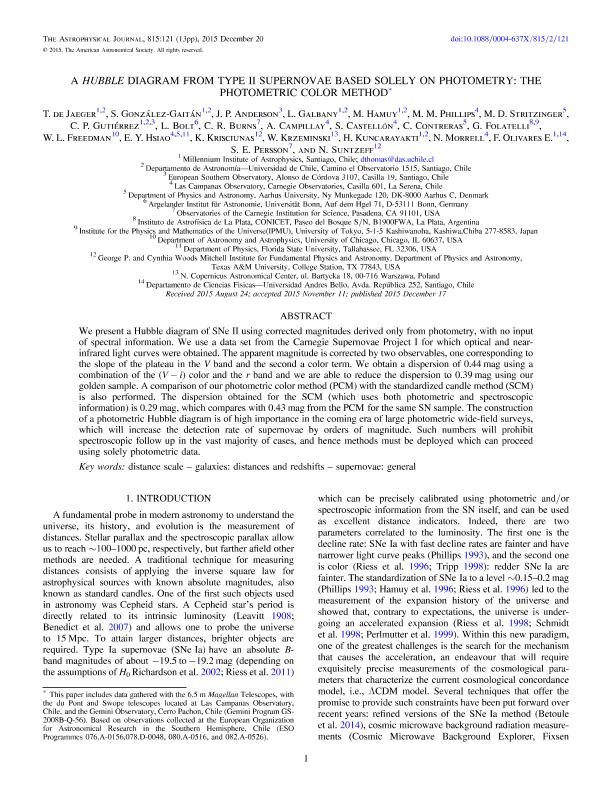Artículo
A Hubble diagram from type II supernovae based solely on photometry: the photometric color method
De Jaeger, T. ; González Gaitán, S.; Anderson, J. P. ; Galbany, L.; Hamuy, M.; Phillips, M. M. ; Stritzinger, M. D.; Gutiérrez, C. P.; Bolt, L.; Burns, C. R. ; Campillay, A.; Castellón, S.; Contreras, C.; Folatelli, Gaston ; Freedman, W. L. ; Hsiao, E. Y. ; Krisciunas, K.; Krzeminski, W.; Kuncarayakti, H.; Morrell, N.; Olivares E. F.; Persson, S. E. ; Suntzeff, N.
; Freedman, W. L. ; Hsiao, E. Y. ; Krisciunas, K.; Krzeminski, W.; Kuncarayakti, H.; Morrell, N.; Olivares E. F.; Persson, S. E. ; Suntzeff, N.
 ; Freedman, W. L. ; Hsiao, E. Y. ; Krisciunas, K.; Krzeminski, W.; Kuncarayakti, H.; Morrell, N.; Olivares E. F.; Persson, S. E. ; Suntzeff, N.
; Freedman, W. L. ; Hsiao, E. Y. ; Krisciunas, K.; Krzeminski, W.; Kuncarayakti, H.; Morrell, N.; Olivares E. F.; Persson, S. E. ; Suntzeff, N.
Fecha de publicación:
12/2015
Editorial:
Iop Publishing
Revista:
Astrophysical Journal
ISSN:
0004-637X
Idioma:
Inglés
Tipo de recurso:
Artículo publicado
Clasificación temática:
Resumen
We present a Hubble diagram of SNe II using corrected magnitudes derived only from photometry, with no input of spectral information. We use a data set from the Carnegie Supernovae Project I for which optical and near-infrared light curves were obtained. The apparent magnitude is corrected by two observables, one corresponding to the slope of the plateau in the V band and the second a color term. We obtain a dispersion of 0.44 mag using a combination of the (V - i) color and the r band and we are able to reduce the dispersion to 0.39 mag using our golden sample. A comparison of our photometric color method (PCM) with the standardized candle method (SCM) is also performed. The dispersion obtained for the SCM (which uses both photometric and spectroscopic information) is 0.29 mag, which compares with 0.43 mag from the PCM for the same SN sample. The construction of a photometric Hubble diagram is of high importance in the coming era of large photometric wide-field surveys, which will increase the detection rate of supernovae by orders of magnitude. Such numbers will prohibit spectroscopic follow up in the vast majority of cases, and hence methods must be deployed which can proceed using solely photometric data.
Palabras clave:
Distance Scale
,
Galaxis
,
Distances
,
Supernovae
,
Redshift
Archivos asociados
Licencia
Identificadores
Colecciones
Articulos(IALP)
Articulos de INST.DE ASTROFISICA LA PLATA
Articulos de INST.DE ASTROFISICA LA PLATA
Citación
De Jaeger, T. ; González Gaitán, S.; Anderson, J. P. ; Galbany, L.; Hamuy, M.; et al.; A Hubble diagram from type II supernovae based solely on photometry: the photometric color method; Iop Publishing; Astrophysical Journal; 815; 2; 12-2015; 121-143
Compartir
Altmétricas



